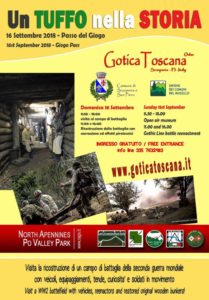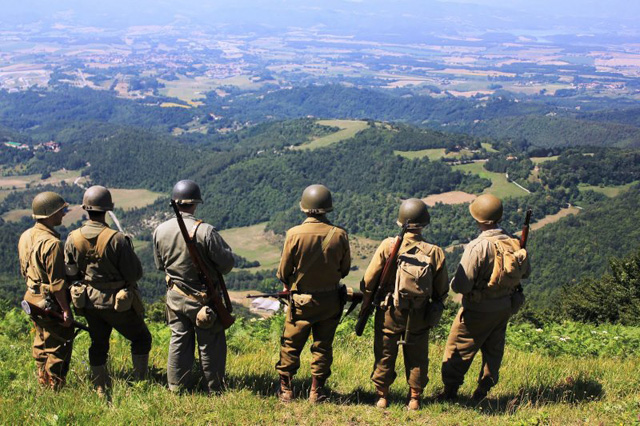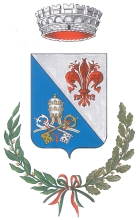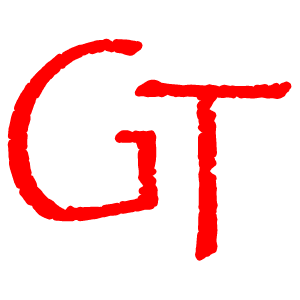A Dive into History®: 1944-2018
Reconstructed visit to a WW2 battlefield with equipment, tents, soldiers and historic vehicles that will retrace the streets of history in the Mugello territories
74th Anniversary of the Battle of Monte Altuzzo
Giogo Pass 16 September 2018
“A Dive into History ®” is a registered trademark of Gotica Toscana onlus.

Download the poster in pdf format

Organized by

with the support of
Municipality of Scarperia and San Piero and the Mountain Union of Mugello Municipalities


The Gotica Toscana non-profit association and the event are registered
in the Tuscan Regional Register of Historical Reconstruction Associations and Events
(LR no. 5 of 12 February 2012).
North Apennines Po Valley Park
Winter Line Museum – Pianoro 3805074820
Museum of the 2nd WW of the Po River – Felonica 348/3157390
Freedom Memorial Museum – Bologna 051/461100
Rover Joe Association – Fidenza
Plan
The event is completely free to the public
Sunday 16 September 2018 – Passo del Giogo
9.30am Opening of the field to the public for the whole day - free entry
11.00am Narrated reconstruction of the battle and the main events with narration and pyrotechnic effects on the field – (first performance)
12.30pm Free lunch
4.00pm Narrated reconstruction of the battle and the main events with narration and pyrotechnic effects on the field – (second performance)
6.00 pm Closing of the event.
How to get to Passo del Giogo
Registration, procedure and regulations for re-enactors
Registration and Costs
The event is completely free for the re-enactors who will take part in the event. Participation in the battle re-enactment is at the participant's discretion and subject to approval by the organization.
Regulation
1) To participate in the event "A dive into History 2018" it is necessary to register by sending a simple email reporting your name, surname and telephone contact to segreteria@goticatoscana.eu or by calling 335/7632983.
2) The registration deadline is the day before the event.
3) Those who wish to book in hotels or farmhouses must make the reservations independently.
4) All military vehicles before 1945 are admitted to the rally.
5) The permitted uniforms must be strictly of the units indicated in the "Admitted combat units" list; uniformed figures without divisional patches will also be accepted as long as they are dressed in accordance with the period and place. Political uniforms including all “SS” formations are not permitted.
6) All participating vehicles need to be in compliance with the CDS; The driver and owner will be directly responsible for any damage to people or things caused by the vehicle. The organization declines any responsibility for damage to people or things inside or outside the camp.
7) All collectors and participants can display uniforms, armaments and equipment in compliance with current regulations; each individual participant will respond individually.
8) Each organized group or individual capable of setting up will be given a portion of land or station based on the type of equipment and the number of participants. Small interventions for the set-up may therefore be created (ditches for tents, individual fox holes, emplacements for machine guns, butcher's broom holes) provided that the ground is restored at the end of the event.
9) All participants are required to behave appropriately to the situation; Any form of violence, harassment and any other disrespectful behavior that could in any way disturb or compromise the outcome of the event is strictly prohibited.
10) During the opening to the public it is strictly forbidden to march, sing, shout, swear, behave disrespectfully towards others, point weapons at people; this rule must be respected at all times in the presence of strangers.
11) No figure is required to engage in politics or express judgments on history, local or general; equipment will be exhibited and further information provided.
12) The organization reserves the right to remove all those who do not respect these regulations without prior notice.
13) All participants are required to follow the instructions of the Camp Manager who will take care of the details by moving the set up areas if necessary and indicating which objects must not enter the museum area; from now on, we advise you not to wear non-vintage watches, glasses, cell phones and anything else that is not vintage.
14) Each group and/or pitch is responsible for the objects on display and is therefore required to preserve their integrity; the groups, in rotation, will supervise the material. It is advisable, based on the list of activities, to bring easily traceable objects (ammunition crates, camouflage nets, tents (small or large), weapons, which can be lent to other collectors upon receipt. The organization is not responsible for theft or damage.
15) For anything not expressly indicated on this site, please contact the organization.
16) During the event, professional photographers will have the task of taking as many photos as possible, taking into account that the topic is "re-enactment".
17)It is strictly forbidden to use fireworks, firecrackers, smoke bombs and anything else that could alarm fire and law enforcement forces. It is also forbidden to light open flames.
Combat Units allowed
Recommended activities and scenes
Americans
1) Artillery station
2) Nursing station
3) Mortar platoon
4) Machine gun platoon
5) GI's in the holes with everything needed: tent, stove, rifle, ammunition, personal effects, etc.
6) Deminers
7) Signal Corps (radios, field telephones)
8) Command
Here are some basic indications on the uniforms to wear, which we provide to help less experienced participants orient themselves in choosing the correct clothing for the occasion. Of course, these are only basic indications, relating only to the most common situations:
In order to ensure a level of historical/uniformological accuracy appropriate to the type of event, the participation of groups or individual historical reconstructors in "A Dive into History 2016" is subject to prior acceptance by the organization
To this end, anyone who wants to take part in the event must commit in advance to observing the standards of clothing and behavior established by the organization.
The main information relating to uniforms and individual equipment is provided below. For any doubts or questions on specific points please contact the organization. For camping material etc., which in any case must respect the same standards of historical accuracy, please refer to direct and preventive agreements between the organization and the participants.
US ARMY
Infantry uniforms and equipment
NB: it is possible to intervene as infantrymen of the 85th Infantry Division or the 91st Infantry Division, but without mixing on the field. It is therefore preferable to operate without dividing humeral badges.
Uniform
a) mandatory
M1 IIGM helmet with USA IIGM underhelmet (original or replica). Post-war European "clones" of the metal shell allowed only if well transformed to look like wartime M1s; USA narrow mesh camouflage net of the type introduced in 1944 allowed; otherwise no camouflage net;
OD wool shirt
OD wool trousers
ordinance belt for trousers
OD ordinance singlet
M43 combat boots with incorporated leather gaiter (the use of canvas gaiters with a low boot, preferably Type II, is exceptionally permitted). Cowhide boots must be mandatory treated with shoe grease..
b) optional
M41 vest or tanker vest
five-button OD wool sweater
OD wool cap with visor (“Jeep cap”)
original or replica US Army raincoat (NB ponchos of any kind are NOT permitted)
equipment
(NB: for the color see the specific notes: OD3 = “khaki”, OD7 = green, “transitional” = mixed OD3/OD7). Where colors are not specified, all three types are fine; “British made” equipment is not permitted, IGM production equipment is possible but to a very limited extent. Better to use equipment produced during the IIGM.
riflemen and deputy foreman
- M1 “Garand” rifle with M1907 leather or M1 OD canvas sling
- Cartridge belt M1923 (OD3 or Transitional) without shoulder straps M1936
- M43 backpack / no backpack (85th Infantry division) or M1928 backpack / no backpack (91st Infantry Division) (NO musette bags allowed)
- Complete water bottle with cup and liner (OD3)
- M43 shovel or M1910 shovel or M1910 pickaxe or M1910 hatchet with case
- M1 bayonet (10 inch blade) with sheath
- M42 (OD3) first aid kit holder
- M6 gas mask holder
Bandolier (OD3 without external stamps), hand grenades (IIGM type fuze) etc. are optional and 1 rifleman in each team will be able to have an ammunition bag, with the role of grenadier (M7 grenade launcher for Garand where available). The use of the "bedding roll" with tent sheet (OD3 with one side open), blankets and tent cord used as a transport lanyard is optional but encouraged.
Auto Rifleman with BAR (1 per squad)
As riflemen above except the following:
- Browning Automatic Rifle with sling as above
- Belt for BAR and M3 knife in M6 or M8 sheath instead of bayonet
Auto Rifleman Assistant (1 per team, optional)
As riflemen above except the following:
- One or two compulsory Garand bandoliers or ammunition bag
- Belt for BAR
Mortar fighters and machine gunners
As riflemen above except the following:
- M1 carbine or M1911A1 pistol with M1916 sheath, pistol belt with magazine pouch for carbine or pistol and M3 knife in M6 or M8 sheath in place of bayonet
Ammunition carriers for mortars and machine guns
As riflemen above except the following:
- (optional) with M2 ammunition bags complete with MG ammunition boxes or mortar fiber containers
Rifle Squad Leader and MG (Staff Sergeant)
As riflemen above except the following:
- M1 helmet with horizontal white stripe on the back
- M1 rifle or M1 carbine or M1928/M1928A1/M1A1 Thompson submachine gun
- If armed with a carbine or machine gun, M3 knife, pistol belt and magazine pouches suitable for the weapon (end-of-war magazine pouches for M3 machine guns are not permitted)
Mortar Squad Leader (Staff Sergeant)
Same as mortars and machine gunners above, except as follows:
18) M3 binoculars, compass with compass holder, mortar sights in M14 leather case
nurse (maximum 1 per platoon)
As riflemen above except the following:
- one or two Red Cross bracelets
- Doctor's equipment with two bags and shoulder straps
- M36 pistol belt
- 1 or 2 complete water bottles
- M42 or M10 (OD3) first aid kit holder
- M6 gas mask holder
NB: M1 helmet with or without red crosses
Junior officers (second lieutenants/lieutenants)
As riflemen above except the following:
- M1 helmet with vertical white band on the back and ranks painted on the front
- M1 carbine (also optional M1911A1 pistol with M1916 sheath), pistol belt with magazine pouch for rifle or pistol and M3 knife in M6 or M8 sheath instead of bayonet
- M1936 backpack (musette bag) (optional M43 backpack)
- Shoulder pads M1936
- Map bag M1938
- M3 binoculars in M17 case
- Compass and compass holder
General Notes on Weapons:
- M1 carbines must be of the type without a bayonet mount
- BARs must have no handle on the barrel
- machine guns must be M1919A4 model without carrying handle on the barrel
- 60 mm mortars should preferably be complete with M308 carrying sling
Uniforms and equipment for the Italian muleteering departments (5th baggage department)
NB: apart from essential clothing, all equipment is considered optional given the role performed
Uniform
grey-green M1933 helmet without weapon decorations with gray-green leather chin strap (optional alpine hat also without pen with field artillery decoration and red tassel with black roundel, or sachet or envelope cap with M42 visor with decorations appropriate to the department of provenance (engineers, artillery, etc.)
GV wool shirt or USA OD wool shirt
Italian colonial cotton trousers M1941 or gray canvas work trousers or Italian GV wool trousers or British Battle Dress trousers dyed dark green
Italian ordinance strap for trousers or US army ordinance belt
Italian M32 boots or US Army low boots, also with US Army gaiters.
M41 jacket without insignia or M42 Saharan smock or Battle dress jacket dyed dark green with insignia appropriate to the department of origin (engineers, artillery, etc.)
equipment
- 91/38 rifle or cavalry musket
- M91 belt with GV pouches and bayonet suitable for the weapon if present
- Tactical bag for walking weapons possibly bundled with blankets and M29 tent tarp (optional)
- Complete M33 water bottle with GV wool
- M31 Gas Mask Pouch / M29 Mounted Weapons Pouch (optional)
Junior officers (second lieutenants/lieutenants)
As muleteers I except the following:
- Alpine officer's hat with field artillery insignia and ranks as required, or possible cord sachet with ranks and insignia as required
- Italian officer's shirt (optional)
- M34 pistol and brown leather ordinance belt/holster
Further notes.
Hairstyles, as well as beards and mustaches, which differ from the style and military regulations of the time, as well as watches, jewelery and other accessories or (visible) tattoos which do not conform to the era represented, will strictly not be permitted.
The use of portable telephones / smartphones or other modern equipment when engaged in performances open to the public is also prohibited. Where necessary, use them, just move away even slightly before using them so as not to frustrate everyone's effort to obtain as accurate a representation as possible.
Germans
1) Mortar station (real existing station with 1 mortar)
2) Refuge setup (existing pitch and refuge entrance) with ammunition boxes, radio, various sheets.
3) Stations with MG (several can be set up since they were there).
4) German soldiers in individual foxholes
5) Sappers who mine
6) Command
Here are some basic indications on the uniforms to wear, which we provide to help less experienced participants orient themselves in choosing the correct clothing for the occasion. Of course, these are only basic indications, relating only to the most common situations:
4th Div. parachute unit uniform (in line from Passo del Giogo to Passo della Futa)
helmet: paratrooper mod.38 (with appropriate color or camouflage)
cap: schiffen sachet with blue or sand luftwaffe M40 markings, alternatively feldmütze with blue luftwaffe M43 markings (Meyer mütze also permitted)
jacket: luftwaffe knockensack III Type splitter camouflage B or sumpftarn, alternatively II Type (shorts, less common). NO throwing jackets with Zeltbahn camouflage!
jacket: Luftwaffe tropenblouse (sand), alternatively fliegerblouse II type (blue cloth). With appropriate displays!
trousers: Luftwaffe tropenhose (sand), alternatively cloth springerhose. The combination of fliegerblouse + tropical trousers is permitted and very common…
boots: 2nd type throwing boots (the first type is also permitted) alternatively low WH boots without gaiters
shirt: lutfwaffe tropenhemd (sand)
WWII style underwear (if visible) with white undershirt or similar, NO T-Shirts of any color.
715th Infantry Div. unit uniform (in line to the left of the yoke pass)
helmet: mod.35 or 42 (with appropriate coloring or camouflage)
cap: schiffen sachet with heer M40 felgrau markings, alternatively feldmütze with heer M43 feldgrau markings
jacket: heer feldblouse schilfgrun (reed green), alternatively feldgrau (in cloth). Models 40, 42 or 43 are preferable. With appropriate displays!
trousers: heer feldhose schilfgrun (reed green), alternatively feldgrau (in cloth)
ankle boots: low WH ankle boots with gaiters, alternatively leather ankle boots
shirt: feldgrau cotton
WWII style underwear (if visible) with white undershirt or similar, NO T-Shirts of any color.
Essential Equipment for Fighters:
K98 rifle with leather strap and related ammunition pouches (in camouflage leather belt or shoulder strap only for paratroopers)
MP38 with leather strap and related ammunition pouches
FG42 with leather strap (only for paratroopers)
leather belt with luftwaffe buckle (for paratroopers) or heer buckle (for infantry) with appropriate shoulder straps for paratroopers or infantrymen (also permitted without)
luftwaffe haversack (for paratroopers) or herr (for infantry)
water bottle, cup and bottle holder
mess tins with cutlery
for all paratroopers: P38 or P08 leather holster (empty or full depending on the case), other holsters only if supplied with short weapons, small holsters for short weapons (PP, PPK etc.) only for officers
for non-commissioned officers and infantry officers: P38 or P08 leather holster (empty or full depending on the case), other holsters only if supplied with short weapons, small holsters for short weapons (PP, PPK etc.) only for officers
Optional equipment for fighters:
backpack of the appropriate color (lufwaffe or heer)
gas mask holder
k98 bayonet with case
document holder (only non-commissioned officers or officers)
binoculars and map holder for graduates / officers etc
spade or folding spade with case
Equipment for special roles:
adopts the essential equipment described above with the necessary adaptations (e.g. machine gunners have tool bags on their belts, nurses have special belt pouches and a white bib with a red cross, etc.
Flying units permitted
TROOPS ENGAGED IN THE BATTLE OF BREAKTHROUGH AT GIOGO PASS 12-18 SEPTEMBER 1944
US Army
Monticelli
On line
363rd Infantry Regiment (91st Infantry Division “Powder River”)
In support – divisional units (91st Infantry Division “Powder River”)
347th Field Artillery Battalion
Company C, 316th Engineer Combat Battalion
Company C, 316th Medical Battalion
Mount Altuzzo
On line
338th Infantry Regiment (85th Infantry Division “Custer”)
In support – divisional units (85th Infantry Division “Custer”)
329th Field Artillery Battalion
Company B, 310th Engineer Combat Battalion
Company B, 310th Medical Battalion
Monticelli / Mt. Altuzzo
In support – attached units
752nd Tank Battalion (Medium)
805th Tank Destroyer Battalion (Self Propelled)
84th Chemical Battalion
105th Antiaircraft Artillery Automatic Weapons Battalion
In support – army corps units (II Army Corps)
178th Field Artillery Group
178th Field Artillery Battalion
248th Field Artillery Battalion
339th Field Artillery Battalion
939th Field Artillery Battalion
423rd Field Artillery Group
697th Field Artillery Battalion
698th Field Artillery Battalion
985th Field Artillery Battalion
Wehrmacht
Monticelli / Mt. Altuzzo
On line
Fallschirm-Jäger-Regiment 12. (4. Fallschirm – Division)
In line – backup unit
Grenadier – Lehr – Brigade
Litauer-Bataillon
Infanterie-Regiment 735 (715 Infanterie – Division)
Divisions-Füsilier-Bataillon 305. (305. Infanterie – Division)
In support – shares of divisional units (4. Fallschirm – Division)
Fallschirm-Jäger-Regiment 11.
Fallschirm-Panzer-Jäger-Abteilung 4.
Fallschirm-Flak Abteilung 4.
Fallschirm-Pionier-Bataillon 4.
Fallschirm-Luftnachrichten-Abteilung 4.
Fallschirm-Sanitäts-Kompanie 41 and 42
Fallschirm-Granatwerfer-Bataillon 4.
In support – shares of army corps units (I Fallschirm – Korps)
Fallschirm-Sturmgeschütz-Brigade 11.
Fallschirm-Artillerie-Regiment 11.
Fallschirm-Granatwerfer-Bataillon 1.
Fallschirm-Luftnachrichten-Abteilung 11.
Fallschirm-Aufklärungs-Abteilung 11.
In support – shares of the Nembo aggregated to the German army
British and Italians
To the right of the 85th Infantry Division were British troops of the 1st Division; Furthermore, in support of the action of the II US Army Corps, departments of the reconstituted Royal Italian Army (210th division) – baggage trains and engineering units – were employed.
English infantrymen and REI infantry, baggage and engineering troops will therefore be admitted.
Italian units attached to German Regiments such as the II Battalion “Mameli” attached to Infanterie-Regiment 735 (715 Infanterie Division) are also admitted.


